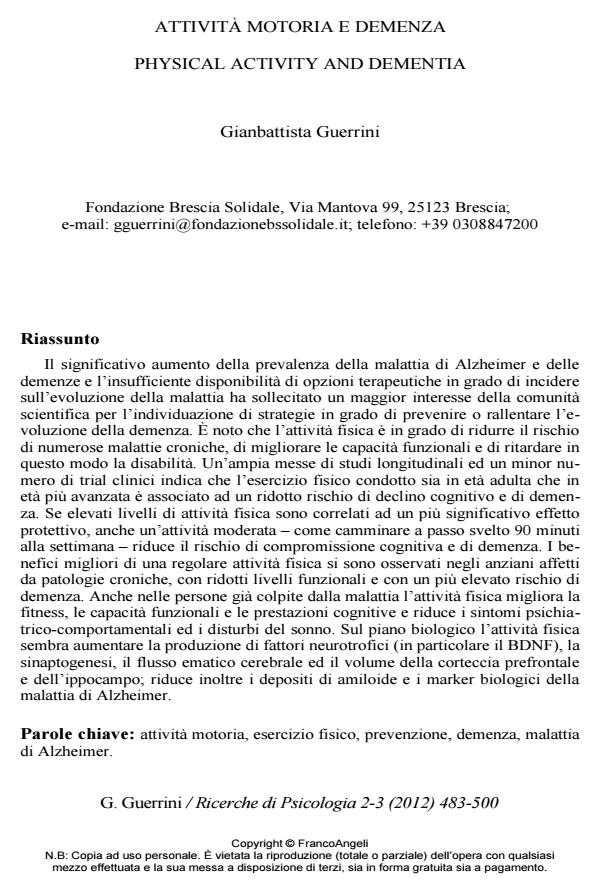Attività motoria e demenza
Titolo Rivista RICERCHE DI PSICOLOGIA
Autori/Curatori Gianbattista Guerrini
Anno di pubblicazione 2013 Fascicolo 2012/2-3
Lingua Italiano Numero pagine 18 P. 483-500 Dimensione file 218 KB
DOI 10.3280/RIP2012-002022
Il DOI è il codice a barre della proprietà intellettuale: per saperne di più
clicca qui
Qui sotto puoi vedere in anteprima la prima pagina di questo articolo.
Se questo articolo ti interessa, lo puoi acquistare (e scaricare in formato pdf) seguendo le facili indicazioni per acquistare il download credit. Acquista Download Credits per scaricare questo Articolo in formato PDF

FrancoAngeli è membro della Publishers International Linking Association, Inc (PILA)associazione indipendente e non profit per facilitare (attraverso i servizi tecnologici implementati da CrossRef.org) l’accesso degli studiosi ai contenuti digitali nelle pubblicazioni professionali e scientifiche
Il significativo aumento della prevalenza della malattia di Alzheimer e delle demenze e l’insufficiente disponibilita di opzioni terapeutiche in grado di incidere sull’evoluzione della malattia ha sollecitato un maggior interesse della comunita scientifica per l’individuazione di strategie in grado di prevenire o rallentare l’evoluzione della demenza. E noto che l’attivita fisica e in grado di ridurre il rischio di numerose malattie croniche, di migliorare le capacita funzionali e di ritardare in questo modo la disabilita. Un’ampia messe di studi longitudinali ed un minor numero di trial clinici indica che l’esercizio fisico condotto sia in eta adulta che in eta piu avanzata e associato ad un ridotto rischio di declino cognitivo e di demenza. Se elevati livelli di attivita fisica sono correlati ad un piu significativo effetto protettivo, anche un’attivita moderata - come camminare a passo svelto 90 minuti alla settimana - riduce il rischio di compromissione cognitiva e di demenza. I benefici migliori di una regolare attivita fisica si sono osservati negli anziani affetti da patologie croniche, con ridotti livelli funzionali e con un piu elevato rischio di demenza. Anche nelle persone gia colpite dalla malattia l’attivita fisica migliora la fitness, le capacita funzionali e le prestazioni cognitive e riduce i sintomi psichiatrico- comportamentali ed i disturbi del sonno. Sul piano biologico l’attivita fisica sembra aumentare la produzione di fattori neurotrofici (in particolare il BDNF), la sinaptogenesi, il flusso ematico cerebrale ed il volume della corteccia prefrontale e dell’ippocampo; riduce inoltre i depositi di amiloide e i marker biologici della malattia di Alzheimer. .
Parole chiave:Attivita motoria, esercizio fisico, prevenzione, demenza, malattia di Alzheimer
Gianbattista Guerrini, Attività motoria e demenza in "RICERCHE DI PSICOLOGIA " 2-3/2012, pp 483-500, DOI: 10.3280/RIP2012-002022